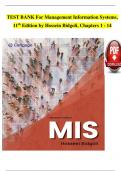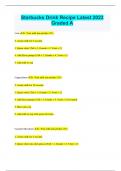TEST BANK For Management Information Systems,
11th Edition by Hossein Bidgoli, Chapters 1 - 14
, Table of Contents
1. Information Systems in Business.
2. Computers and Their Business Applications.
3. Data and Business Intelligence.
4. Personal, Legal, Ethical, and Organizational Issues.
5. Protecting Information Resources.
6. Data Communication: Delivering Information Anywhere and Anytime.
7. A Connected World.
8. E-Commerce.
9. Global Information Systems.
10. Building Successful Information Systems.
11. Enterprise Systems.
12. Supporting Decisions and Processes.
13. Artificial Intelligence and Automation.
14. Emerging Trends, Technologies, and Applications.
,1. Information Systems in Business.
2.
True / False
1. When repetitive transaction-processing operations are automated, human involvement is increasingly required.
a. True
b. False
ANSWER: False
RATIONALE: Correct
Computers are most beneficial in transaction- processing operations. These operations are
repetitive, such as printing numerous checks, or involve enormous volumes of data, such as
inventory control in a multinational textile company. When these systems are automated,
human involvement is minimal. See 1-3:The Beginning: Transaction-Processing Systems
POINTS: 1
DIFFICULTY: Easy
REFERENCES: Define transaction-processing systems
QUESTION TYPE: True / False
HAS VARIABLES: False
LEARNING OBJECTIVES: MIS.10e.1.3
TOPICS: Information systems
Information systems importance
KEYWORDS: Remember
DATE CREATED: 10/22/2019 1:26 PM
DATE MODIFIED: 11/20/2019 7:17 PM
2. Information systems are broader in scope than information technologies.
a. True
b. False
ANSWER: True
RATIONALE: Correct
Information systems are broader in scope than information technologies, but the two
overlap in many areas. Both are used to help organizations be more competitive and to
improve their overall efficiency and effectiveness. See 1-1: Computers and Information
Systems in Daily Life
POINTS: 1
DIFFICULTY: Moderate
REFERENCES: Discuss common applications of computers and information systems.
QUESTION TYPE: True / False
HAS VARIABLES: False
LEARNING OBJECTIVES: MIS.10e.1.1
TOPICS: Information systems
Information systems importance
KEYWORDS: Understand
DATE CREATED: 10/22/2019 1:26 PM
,DATE MODIFIED: 10/22/2019 1:26 PM
3. In a management information system (MIS) application, processes are usually methods for performing a task.
a. True
, b. False
ANSWER: True
RATIONALE: Correct
In an MIS application, processes are usually methods for performing a task. See 1-4:
Management Information Systems
POINTS: 1
DIFFICULTY: Moderate
REFERENCES: Define management information systems.
QUESTION TYPE: True / False
HAS VARIABLES: False
LEARNING OBJECTIVES: MIS.10e.1.4
TOPICS: Management information systems
KEYWORDS: Remember
DATE CREATED: 10/22/2019 1:26 PM
DATE MODIFIED: 10/22/2019 1:26 PM
4. In designing a management information system (MIS), the first task is to collect data and analyze it.
a. True
b. False
ANSWER: False
RATIONALE: Correct
In designing an MIS, the first task is to clearly define the system’s objectives. See 1-4:
Management Information Systems
POINTS: 1
DIFFICULTY: Moderate
REFERENCES: Define management information systems.
QUESTION TYPE: True / False
HAS VARIABLES: False
LEARNING OBJECTIVES: MIS.10e.1.4
TOPICS: Management information systems
KEYWORDS: Remember
DATE CREATED: 10/22/2019 1:26 PM
DATE MODIFIED: 10/22/2019 1:26 PM
5. An information system should collect data from both external and internal sources, although organizational objectives
and the type of application also determine what sources to use.
a. True
b. False
ANSWER: True
RATIONALE: Correct
The information that users need affects the type of data that is collected and used. An
information system should collect data from both external and internal sources, although
organizational objectives and the type of application also determine what sources to use.
See 1-5: Major Components of an Information System
POINTS: 1
,DIFFICULTY: Moderate
REFERENCES: Describe the four major components of an information system.
QUESTION TYPE: True / False
HAS VARIABLES: False
LEARNING OBJECTIVES: MIS.10e.1.1
TOPICS: Information system components
KEYWORDS: Understand
DATE CREATED: 10/22/2019 1:26 PM
DATE MODIFIED: 10/22/2019 1:26 PM
6. Customers, competitors, and suppliers are examples of internal data sources of an information system.
a. True
b. False
ANSWER: False
RATIONALE: Correct
Customers, competitors, and suppliers are examples of external data sources of an
information system. See 1-5: Major Components of an Information System
POINTS: 1
DIFFICULTY: Easy
REFERENCES: Discuss the differences between data and information.
QUESTION TYPE: True / False
HAS VARIABLES: False
LEARNING OBJECTIVES: MIS.10e.1.1
TOPICS: Information system components
KEYWORDS: Understand
DATE CREATED: 10/22/2019 1:26 PM
DATE MODIFIED: 10/22/2019 1:26 PM
7. In a management information system (MIS), the quality of information is determined by its usefulness to users, and its
usefulness determines the success of an information system.
a. True
b. False
ANSWER: True
RATIONALE: Correct
In an MIS, the quality of information is determined by its usefulness to users, and its
usefulness determines the success of an information system. See 1-5: Major Components
of an Information System
POINTS: 1
DIFFICULTY: Moderate
REFERENCES: Describe the differences between data and information.
QUESTION TYPE: True / False
HAS VARIABLES: False
LEARNING OBJECTIVES: MIS.10e.1.1
TOPICS: Information system components
KEYWORDS: Understand
,DATE CREATED: 10/22/2019 1:26 PM
DATE MODIFIED: 11/19/2019 1:53 PM
8. To be useful, information must be able to integrate with other data and information.
a. True
b. False
ANSWER: True
RATIONALE: Correct
To be useful, information must be able to integrate with other data and information. See 1-
5: Major Components of an Information System
POINTS: 1
DIFFICULTY: Moderate
REFERENCES: Describe the differences between data and information.
QUESTION TYPE: True / False
HAS VARIABLES: False
LEARNING OBJECTIVES: MIS.10e.1.1
TOPICS: Information system components
KEYWORDS: Understand
DATE CREATED: 10/22/2019 1:26 PM
DATE MODIFIED: 10/22/2019 1:26 PM
9. When solving problems, the users of an information system must avoid using informal information.
a. True
b. False
ANSWER: False
RATIONALE: Correct
In addition to the formal information that an information system generates, users need to be
able to make use of informal information-such as rumors, unconfirmed reports, and stories-
when solving problems. See 1-5: Major Components of an Information System
POINTS: 1
DIFFICULTY: Moderate
REFERENCES: Describe the differences between data and information.
QUESTION TYPE: True / False
HAS VARIABLES: False
LEARNING OBJECTIVES: MIS.10e.1.1
TOPICS: Information system components
KEYWORDS: Understand
DATE CREATED: 10/22/2019 1:26 PM
DATE MODIFIED: 10/22/2019 1:26 PM
10. The main difference between an intranet and the Internet is that intranets are public and the Internet is private.
a. True
b. False
ANSWER: False
RATIONALE: Correct
, The main difference between an intranet and the Internet is that intranets are private and
the Internet is public. See 1-6: Using Information Systems and Information Technologies
POINTS: 1
DIFFICULTY: Moderate
REFERENCES: Explain the importance and applications of information systems in functional areas
of a business.
QUESTION TYPE: True / False
HAS VARIABLES: False
LEARNING OBJECTIVES: MIS.10e.1.7
TOPICS: Information systems
Information technologies
KEYWORDS: Understand
DATE CREATED: 10/22/2019 1:26 PM
DATE MODIFIED: 10/22/2019 1:26 PM
11. A logistics information system supports decisions related to providing reports and statistics on employee
demographics.
a. True
b. False
ANSWER: False
RATIONALE: Correct
A personnel information system supports decisions related to providing reports and
statistics on employee demographics. See 1-6: Using Information Systems and Information
Technologies
POINTS: 1
DIFFICULTY: Easy
REFERENCES: Explain the importance and applications of information systems in functional areas
of a business.
QUESTION TYPE: True / False
HAS VARIABLES: False
LEARNING OBJECTIVES: MIS.10e.1.7
TOPICS: Information systems
Information technologies
KEYWORDS: Understand
DATE CREATED: 10/22/2019 1:26 PM
DATE MODIFIED: 10/22/2019 1:26 PM
12. An effective financial information system should provide timely, accurate, and integrated information about the
marketing mix, or 4Ps: price, promotion, place, and product.
a. True
b. False
ANSWER: False
RATIONALE: Correct
An effective marketing information system should provide timely, accurate, and integrated
information about the marketing mix-4Ps: price, promotion, place, and product. See 1-6:
Using Information Systems and Information Technologies
, POINTS: 1
DIFFICULTY: Moderate
REFERENCES: Explain the importance and applications of information systems in functional areas
of a business.
QUESTION TYPE: True / False
HAS VARIABLES: False
LEARNING OBJECTIVES: MIS.10e.1.7
TOPICS: Information systems
Information technologies
KEYWORDS: Understand
DATE CREATED: 10/22/2019 1:26 PM
DATE MODIFIED: 11/19/2019 5:30 PM
13. The threat of new entrants into the marketplace is high when duplicating a company’s product or service is difficult.
a. True
b. False
ANSWER: False
RATIONALE: Correct
The threat of new entrants into the marketplace is low when duplicating a company’s
product or service is difficult. See 1-6: Using Information Systems and Information
Technologies
POINTS: 1
DIFFICULTY: Moderate
REFERENCES: Apply the Five Forces Model and strategies for gaining a competitive advantage.
QUESTION TYPE: True / False
HAS VARIABLES: False
LEARNING OBJECTIVES: MIS.10e.1.9
TOPICS: Five Forces Model
KEYWORDS: Apply
DATE CREATED: 10/22/2019 1:26 PM
DATE MODIFIED: 10/22/2019 1:26 PM
14. Rivalry among existing competitors is high when many competitors occupy the same marketplace position.
a. True
b. False
ANSWER: True
RATIONALE: Correct
Rivalry among existing competitors is high when many competitors occupy the same
marketplace position; it is low when there are few competitors. See 1-6: Using Information
Systems and Information Technologies
POINTS: 1
DIFFICULTY: Moderate
REFERENCES: Apply the Five Forces Model and strategies for gaining a competitive advantage.
QUESTION TYPE: True / False
HAS VARIABLES: False





